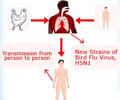While some scientists report engineering a super virulent strain of the H5N1 influenza virus, which could potentially wipe out a significant percentage of the human population, another

"We hope this study will ultimately benefit individuals—especially the young—who succumb to a severe form of flu infection," said Ling-Pei Ho, M.D., Ph.D., the researcher who led the work from the MRC Human Immunology Unit, Oxford University in Oxford, United Kingdom. "The study highlights a key immune process that occurs in severe flu infection, and provides a platform for a new approach and further research in this area."
To make their discovery, scientists infected three groups of mice with H1N1 flu virus. (Note: this is NOT the H5N1 flu virus that has been at the center of recent controversy.) The first group included normal mice; the second group was devoid of natural killer T cells, and the third was given a treatment that specifically activated natural killer T cells. Researchers observed the outcome of flu infection and found that the mice without natural killer T cells did worst, and those with activated killer T cells did best. Mice that lacked natural killer T cells had increased amounts of monocytes in the lungs, and severe lung injury similar to those seen in Spanish flu and lethal swine flu. Using highly-sensitive fluorescent antibody technology, this study was one of the first to document the sequential changes in innate immune response in the lungs during severe flu infection. These findings essentially provide a "road map" of the chronological changes in the lungs during severe flu infection.
"Despite affecting practically everyone, the flu may be one of the most underestimated viruses in terms of its devastating potential," said John Wherry, Ph.D., Deputy Editor of the Journal of Leukocyte Biology. "As the H5N1 research shows, it is quite possible for the virus to mutate or be bioengineered into a form that could wipe most of us out. What most people don't realize is that the severe illness from these flu strains is caused by both the virus and an overaggressive or inappropriate immune response. Research like this, however, offers hope that we'll be able to find more universal ways improve the effectiveness of immunity and combat the severe strains of the flu."
Source-Eurekalert
 MEDINDIA
MEDINDIA




 Email
Email






